Home -> Vectors -> Fleas -> Morphology
MORPHOLOGY
Fleas are darkbrown in colour, wingless and possess a laterally compressed chitineous abdomen (Soulsby, 1982). The glossy surface of the body allows easy movement through hair and feathers (Urquhart et al., 1987). Compound eyes are absent, but some species have large or small simple eyes. The legs are long, strong and adapted for leaping (Soulsby, 1982). This can especially be seen in the third pair of legs which is much longer than the others (Urquhart et al., 1987) and muscular. In some species, there are a number of large spines on the head and the thorax known as ‘combs’ or ctenidia. There may be a genal comb on the cheek (gena) and a pronotal comb on the posterior border of the first thoracic segment (Soulsby, 1982). These combs or ctenidia belong to one of the three sets of characteristics in morphological taxonomy for identifying fleas. Thoracic and leg structures and the structure of the male segment IX, the female sternite VII and the sperm holding organ (spermatheca) are the other two characterising sets (Ménier and Beaucournu, 1998).
Morphology of flea species of veterinary importance
On pets, particularly on cats and dogs, only a restricted number of flea species occur in large amounts with any regularity to be of importance as nuisance pests.
For the USA these are Ctenocephalides felis, the cat flea, Ctenocephalides canis, the dog flea, Pulex irritans, the human flea, and Echidnophaga gallinacea as well as Ceratophyllus gallinae, fleas found on poultry (Kalkofen and Greenburg, 1974; Amin, 1976; Harman et al., 1987; Dryden, 1988).
Similar situations are also found in Europe and other parts of the world with C. felis and C. canis mainly dominating and P. irritans and Archaeopsylla erinacei, the flea of the hedgehog, as species of possible high rates of infestations (24% (Baker and Hatch, 1972) and 8.3% (Kristensen et al., 1978)).

The morphological differentiation between the two most relevant species of veterinary importance C. felis and C. canis as well as some other major flea species is given in below.
Morphological differentiation of the cat flea (Ctenocephalides felis) and the dog flea (Ctenocephalides canis)
| Ctenocephalides felis | Ctenocephalides canis | |
| Shape of head capsule | Male  Female  | Male  Female  |
| Spine 1 and 2 of the genal comb | 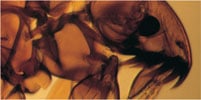 Both 1st and 2nd spine | 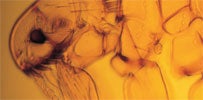 1st spine is half as long |
| Number of teeth of tibiae | 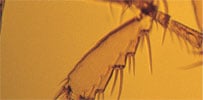 Tibiae of all 6 legs have | 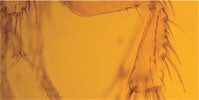 Tibiae of all 6 legs have |
General morphological differentiation using the presence or absence of pronotal and genal combs in fleas
| Without combs present | Only pronotal combs present | Only few pronotal and genal combs present | Several pronotal and genal combs present |
| Xenopsylla cheopis (Oriental rat flea) | Nosopsyllus fasciatus (Northern rat flea) | Ischnopsylliadae (Bat fleas) | Spilopsyllus cuniculi (European rabbit flea) |
| Pulex irritans (Human flea) | Ceratophyllus gallinae (Poultry flea) | Archaeophsylla errinacei (Hedgehog flea) | Leptopsylla segnis (European mouse flea) |
| Echidnophaga gallinacea (Sticktight flea) | Diamanus montanus (Ground squirrel flea) | Ctenocephalides canis (Dog flea) | |
| Orchopeas howardii (Squirrel flea) | Ctenocephalides felis (Cat flea) | ||
| Cediopsylla simplex (Common eastern rabbit flea) |
References
Amin OM: Host associations and seasonal occurrence of fleas from southeastern Wisconsin mammals, with observations on morphologic variations. J Med Entomol. 1976, 13, 179-92
Baker KP, Hatch C: The species of fleas found on Dublin dogs. Vet Rec. 1972, 91, 151-2
Dryden MW: Evaluation of certain parameters in the bionomics of Ctenocephalides felis felis (Bouché 1835). 1988, MS Thesis, Purdue University, West Lafayette
Harman DA, Halliwell RE, Greiner EC: Flea species from dogs and cats in North-Central Florida. Vet Parasitol. 1987, 23, 135-40
Kalkofen UP, Greenberg J: Public health implications of Pulex irritans infestations of dogs. Am Vet Med Assoc. 1974, 165, 903-5
Kristensen S, Haarløv N, Mourier H: A study of skin diseases in dogs and cats. IV. Patterns of flea infestation in dogs and cats in Denmark. Nord Vet Med. 1978, 30, 401-13
Ménier K, Beaucournu JC: Taxonomic study of the genus Ctenocephalides Stiles & Collins, 1930 (Insecta: Siphonaptera: Pulicidae) by using aedegous characters. J Med Entomol. 1998, 35, 883-90
Soulsby EJL (ed.): Helminths, arthropods and protozoa of domesticated animals. 7th edn., 1982, Lea & Febiger, Philadelphia
Urquhart GM, Armour J, Duncan J, et al. (eds.): Order Siphonaptera. In: Veterinary parasitology. 1987, Longman Scientific & Technical, Essex, England, pp. 171-5
EXPLORE OUR CONTENT
 CVBD MapsThe CVBD Occurence World Map presents country-specific situations based on current scientific knowledge and feed-back from experts around the world in an easy-to-grasped way. |
| Read more-> |
 ResourcesElanco Animal Health supports education in parasitology and especially in the field of vector-borne diseases. Access image collections, discover the World Forum calendar, interesting links and our glossary. |
| Read more-> |
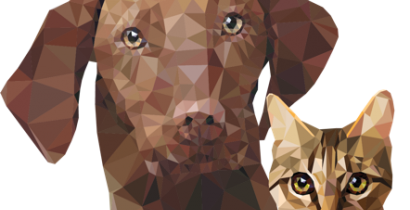 CVBD World ForumThe CVBD World Forum is a working group of leading international experts with the mission to enhance knowledge and communication on companion animal vector-borne diseases for the improvement of animal, human, and environmental health. |
| Read more-> |
